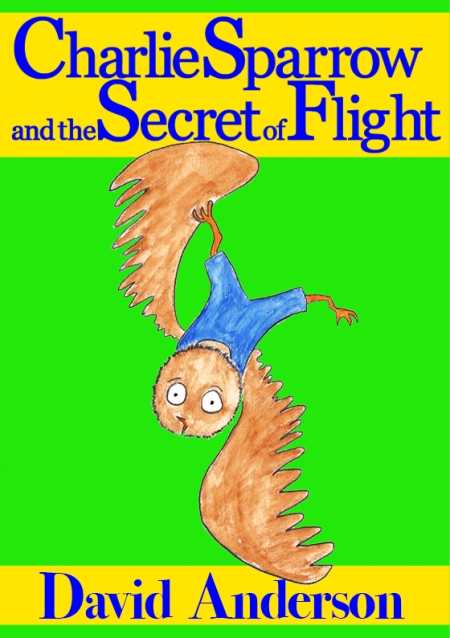Charlie Sparrow and the Secret of Flight
Charlie Sparrow and the Secret of Flight is a clever, fun story for children who have graduated to chapter books. The book is particularly well written, and while some of the vocabulary may be challenging for the youngest readers, the story will appeal to ages six to nine.
Author and illustrator David Anderson has created an ingenious little community—all the residents are birds, including his main character, Charlie, a sparrow chick. Charlie’s friends are birds of many different species and varieties. Amazingly, the birds all believe that their wings are arms, and not one of them knows how to fly. The structure of the community and the exploits of the bird children and their elders represent a familiar environment. Readers will feel comfortable, allowing them to identify with the characters as if they were human.
Anderson’s brightly colored drawings on the cover, and black and white pencil drawings inside, look like the art that many children bring home from school. His style speaks of cartoons and crayons. While the illustrations may appear amateurish to adults, they suit the story nicely, almost as if Charlie might have drawn them.
Anderson’s tale follows an unusual path in order to teach a valuable lesson. Young Charlie has a special talent that makes him different. Differences are not encouraged in his community, and while some of his friends and a few others are enthralled by Charlie’s abilities, most of the adults, including his parents, want to “cure” him of what they consider atypical behavior. Although not intentionally defiant, Charlie simply cannot help himself; his differences are too much a part of who he is, and he can neither hide them nor stop being himself.
Some parents may find it objectionable that he breaks the law (as does another character) and suffers no serious consequences. By the end of the story, the community begins to find inspiration in Charlie and slowly starts to change. It is their recognition of the value of Charlie’s differences that illustrates the book’s message: Everyone should be encouraged to “accept themselves for who they are.”
Anderson is an imaginative writer, and his characters are a delight. His choices of specific kinds of birds for their various roles are both silly and apt. A stork with a monocle is an attorney, for instance, while peacocks serve as court bailiffs, and a hawk is the community’s safety inspector. The Geese Police are especially funny. Meanwhile, Charlie, the simplest of plain brown birds, is the one with the greatest talent.
Charlie Sparrow and the Secret of Flight promises an enjoyable read. The text itself is well edited, although there are a few small errors and two minor inconsistencies (information about characters appears before the characters themselves have revealed it). Anderson has developed a marvelous cast of characters, and continuing with the further adventures of Charlie Sparrow seems the perfect use of this author’s creative talents.
Reviewed by
Cheryl Hibbard
Disclosure: This article is not an endorsement, but a review. The publisher of this book provided free copies of the book and paid a small fee to have their book reviewed by a professional reviewer. Foreword Reviews and Clarion Reviews make no guarantee that the publisher will receive a positive review. Foreword Magazine, Inc. is disclosing this in accordance with the Federal Trade Commission’s 16 CFR, Part 255.

